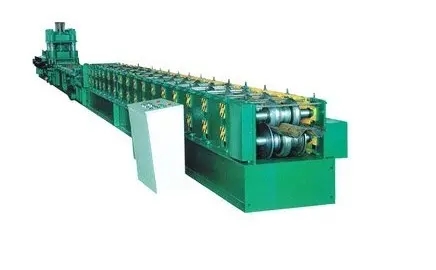Understanding Mould Cutting Downpipe Roll Forming Machines
The construction industry relies heavily on efficient manufacturing processes to produce quality products quickly and cost-effectively. One of the significant innovations in this domain is the mould cutting downpipe roll forming machine, which plays a crucial role in the production of downpipes. Downpipes are essential components of drainage systems that direct rainwater from roofs to the ground or drainage systems, preventing water accumulation that could cause structural damage. This article explores the functionalities, advantages, and applications of mould cutting downpipe roll forming machines.
What is a Mould Cutting Downpipe Roll Forming Machine?
A mould cutting downpipe roll forming machine is a specialized piece of industrial machinery designed to produce downpipes through a continuous roll forming process. The machine employs a series of rollers to shape flat metal strips into tubular forms. The mould cutting aspect refers to the machine's capability to cut the formed pipes to specific lengths, ensuring uniformity and meeting varied design requirements.
The process begins with a metal coil (usually made of galvanized steel or aluminum) being fed into the machine. As the coil passes through a series of rollers, it is gradually shaped into the desired profile of a downpipe. Once the desired shape is achieved, the machine utilizes a cutting mechanism that trims the pipe to specified lengths, completing the manufacturing process.
Key Advantages
1. Efficiency The roll forming process is highly efficient, allowing for continuous production without significant interruptions. This means that manufacturers can produce large quantities of downpipes in a short period, meeting high demand.
2. Consistency The automated nature of the mould cutting downpipe roll forming machine ensures that each downpipe produced has consistent dimensions and quality. This uniformity is critical for installation and overall system performance.
3. Customization Different construction projects may require various downpipe sizes and shapes. These machines can be easily adjusted to create custom profiles, enabling manufacturers to meet specific customer requirements.
4. Cost-Effectiveness Though the initial investment in a roll forming machine can be substantial, the long-term savings and increased output often justify the expenditure. The ability to produce high volumes reduces labor costs and minimizes material waste.
mould cutting downpipe roll forming machine
5. Durability of Products The materials used in downpipe production are generally robust, ensuring that the final products can withstand harsh weather conditions. This durability is crucial for maintaining the integrity of building drainage systems.
Applications of Downpipes
Downpipes manufactured by mould cutting roll forming machines find extensive applications in various sectors
- Residential Construction Downpipes are essential for managing rainwater from homes, ensuring effective drainage and preventing water damage.
- Commercial Buildings Larger edifices require efficient water management systems, making downpipes vital in urban development.
- Infrastructure Projects Public facilities, such as schools and hospitals, benefit from reliable drainage systems supported by durable downpipes.
- Industrial Applications Factories and warehouses often need customized downpipe solutions for their unique architectural requirements.
Conclusion
Mould cutting downpipe roll forming machines represent a significant advancement in the field of manufacturing and construction. Their ability to produce high-quality, consistent, and customized downpipes efficiently addresses the growing needs of the construction industry. As technology advances and the demand for sustainable construction practices increases, these machines will likely continue to play a pivotal role in shaping the future of drainage solutions across various sectors. Embracing these advancements can contribute to more effective water management systems, ultimately leading to safer and more resilient structures.







